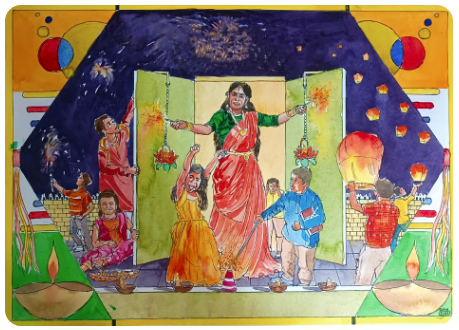A smiling child is the purest form of beauty.
The most precious gift life gives to a living being is a child, and to take care of this gift is not just happiness, but a responsibility, a way to express gratitude towards life, nature and this world we inhabit.Our first Prime Minister, Pt. Jawaharlal Nehru loved children dearly and is fondly remembered as Chacha Nehru by them. In 1964, to commemorate his birth anniversary , 14th November, his birthday was declared as Children’s Day nationwide.
Blooming like vibrant hues of flowers in a garden, children are the tiny saplings of future trees.
With their endless wonder and innocent questions, their awe- filled eyes and toothy smile, chubby cheeks, pudgy hands, curious minds and tiny hearts full of love for all, they are the brightest stars of life.
Along with paying honour to Pandit Nehru, this day strives to raise awareness of their rights, care, and education. He wanted the children to be happy and zestful for life- traits which like all other learning, start from home. This day serves as an ideal moment to reflect on the needs and desires of a child, and how we as parents, guides, educators, elders and friends can help them bloom to their fullest.
So, what does a child need to be happy?
The answer lies beyond the seemingly important paraphernalia of riches, comforts and toys, and we find that the essentials are time, love, education, discipline and security.
Remember, time means the time of parents/ elders or family members not of helpers. We must remember that helpers are to ‘help’ us in certain areas so that ‘we can have time’ with the child, not the other way round.
Love means the patient love and empathy towards a growing child which is free of deadlines, conditions of our mood and situation, and which is not in the form of ‘anything my child puts his/her hands on’.
We must learn to differentiate between ‘buying a toy as a gift’ versus ‘ gifting a toy as a bribe’ to get rid of our passive guilt of not being with them or being impatient with them.
Similarly, education needs to be exceptionally well crafted, not merely branded. And discipline needs to be taught through our actions instead of compelling them to follow it. As Joseph Joubert , a French moralist has rightly said, ” Children need models rather than critics”
We must ensure that a child feels safe and secure.
Children with a strong sense of security grow-up as emotionally stable, responsible adults in relationships as well as social citizens.
Another aspect of raising a child with great emotional, mental, physical and psychological health is to spend quality play time with them. It leads to building team spirit, quick thinking, decision making and a plethora of other abilities in children.
Like, playing outdoors develops stamina, fitness and motor skills , while playing an indoor game leads to strong connections, memories and harmony.
A happy childhood is the best inheritance you can leave for your child even if you are not as rich , as smart, as happening as anyone else and find it hard to keep up with the Joneses.
A happy child is the sign of a future happy nation and there’s no better way of understanding a society than to observe how they treat their children.
If we raise them happy and healthy in childhood we’d be saved from the gargantuan task of reforming depressed grown ups and repairing broken adults.
So, for happy children let’s become happy parents… not just happy parents, but happy uncles and aunts, happy excited teachers, relatives, family friends, a smiling postmaster , a jolly electrician, a kind shopkeeper, a welcoming librarian, an empathetic neighbour…
In a multitude of forms we are constantly affecting them, like anything which falls on wet cement leaves an imprint, WE in myriad interactions impress something upon their impressionable minds, so let’s be sure of a beautiful imprint.
That will be the true celebration of Children’s Day.







